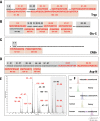Alpha-synuclein post-translational modifications as potential biomarkers for Parkinson disease and other synucleinopathies
- PMID: 23966418
- PMCID: PMC3861707
- DOI: 10.1074/mcp.R113.032730
Alpha-synuclein post-translational modifications as potential biomarkers for Parkinson disease and other synucleinopathies
Abstract
The development of novel therapies against neurodegenerative disorders requires the ability to detect their early, presymptomatic manifestations in order to enable treatment before irreversible cellular damage occurs. Precocious signs indicative of neurodegeneration include characteristic changes in certain protein levels, which can be used as diagnostic biomarkers when they can be detected in fluids such as blood plasma or cerebrospinal fluid. In the case of synucleinopathies, cerebrospinal alpha-synuclein (α-syn) has attracted great interest as a potential biomarker; however, there is ongoing debate regarding the association between cerebrospinal α-syn levels and neurodegeneration in Parkinson disease and synucleinopathies. Post-translational modifications (PTMs) have emerged as important determinants of α-syn's physiological and pathological functions. Several PTMs are enriched within Lewy bodies and exist at higher levels in α-synucleinopathy brains, suggesting that certain modified forms of α-syn might be more relevant biomarkers than the total α-syn levels. However, the quantification of PTMs in bodily fluids poses several challenges. This review describes the limitations of current immunoassay-based α-syn quantification methods and highlights how these limitations can be overcome using novel mass-spectrometry-based assays. In addition, we describe how advances in chemical synthesis, which have enabled the preparation of α-syn proteins that are site-specifically modified at single or multiple residues, can facilitate the development of more accurate assays for detecting and quantifying α-syn PTMs in health and disease.
Figures





References
-
- Lang A. E., Lozano A. M. (1998) Parkinson's disease. First of two parts. N. Engl. J. Med. 339, 1044–1053 - PubMed
-
- Lang A. E., Lozano A. M. (1998) Parkinson's disease. Second of two parts. N. Engl. J. Med. 339, 1130–1143 - PubMed
-
- Lesage S., Anheim M., Letournel F., Bousset L., Honore A., Rozas N., Pieri L., Madiona K., Durr A., Melki R., Verny C., Brice A. (2013) G51D alpha-synuclein mutation causes a novel parkinsonian-pyramidal syndrome. Ann. Neurol. 73, 459–471 - PubMed
-
- Polymeropoulos M. H., Lavedan C., Leroy E., Ide S. E., Dehejia A., Dutra A., Pike B., Root H., Rubenstein J., Boyer R., Stenroos E. S., Chandrasekharappa S., Athanassiadou A., Papapetropoulos T., Johnson W. G., Lazzarini A. M., Duvoisin R. C., Di Iorio G., Golbe L. I., Nussbaum R. L. (1997) Mutation in the alpha-synuclein gene identified in families with Parkinson's disease. Science 276, 2045–2047 - PubMed
Publication types
MeSH terms
Substances
LinkOut - more resources
Full Text Sources
Other Literature Sources
Medical
Miscellaneous

